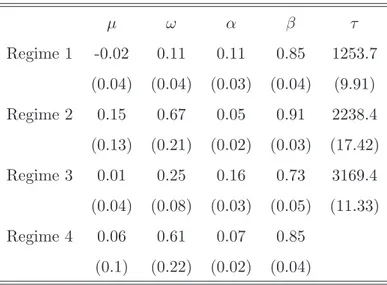Evolutionary Sequential Monte Carlo Samplers for Change-points Models
Texte intégral
Figure

![Table 3: Prior Distributions of the CP parameters. The distribution N (a, b) denotes the Normal distribution with expectation a and variance b and U[a,b] stands for the Uniform distribution with lower bound a and upper bound b](https://thumb-eu.123doks.com/thumbv2/123doknet/7672617.240415/24.892.196.709.443.661/distributions-parameters-distribution-distribution-expectation-variance-uniform-distribution.webp)


Documents relatifs
Nous venons de la rencontrer consisté en l'absence de tout nom et c'est évidement l'anonymat (ex.. ﻈﻨﻤﻟﺍ ﻦﻣ ﺔﻴﺟﺭﺎﺨﻟﺍ ﺕﺎﺒﺘﻌﻟﺍ ﺓﺮﻫﺎﻇ ﻲﺛﺍﺪﺤﻟﺍ ﺭﻮ ﺔﺑﺎﺘﻛ ﻑﺪﻫ ﻥﺇ
Lors d'un séjour à Dinard en 1951, je les ai comparées aux échan- tillons des côtes françaises de Bretagne et j'ai pu remarquer qu'il existait entre les
• La Stratégie nationale pour la biodiversité vise, entre autres, à l'amélioration de la trame écologique dont un des buts est de permettre le déplacement des aires de
Figure 9 shows the I/F map, illumination corrected using the Lommel-Seeliger disk law, of the comet obtained on 29 July with the NAC green filter, at the lowest phase angle (1.3 ◦
In Section 4 we show some results on the Collins e↵ect for transversely polarized u quark jets and compare them with the Collins asymmetries measured by the COMPASS Collaboration
Nous souscrivons donc aux recommandations européennes les plus récentes concernant le traitement anticoagulant et antiagrégant des patients atteints de fibrillation auriculaire (et
• The initial motivation of quasi Monte Carlo (QMC) is to use low discrepancy vectors instead of unconstrained random vectors in order to improve the calculation of integrals via
The latter, also called particle filtering, focuses on sampling in state space models based on sequential data, while the former’s initial goal is to enhance Monte Carlo efficiency



